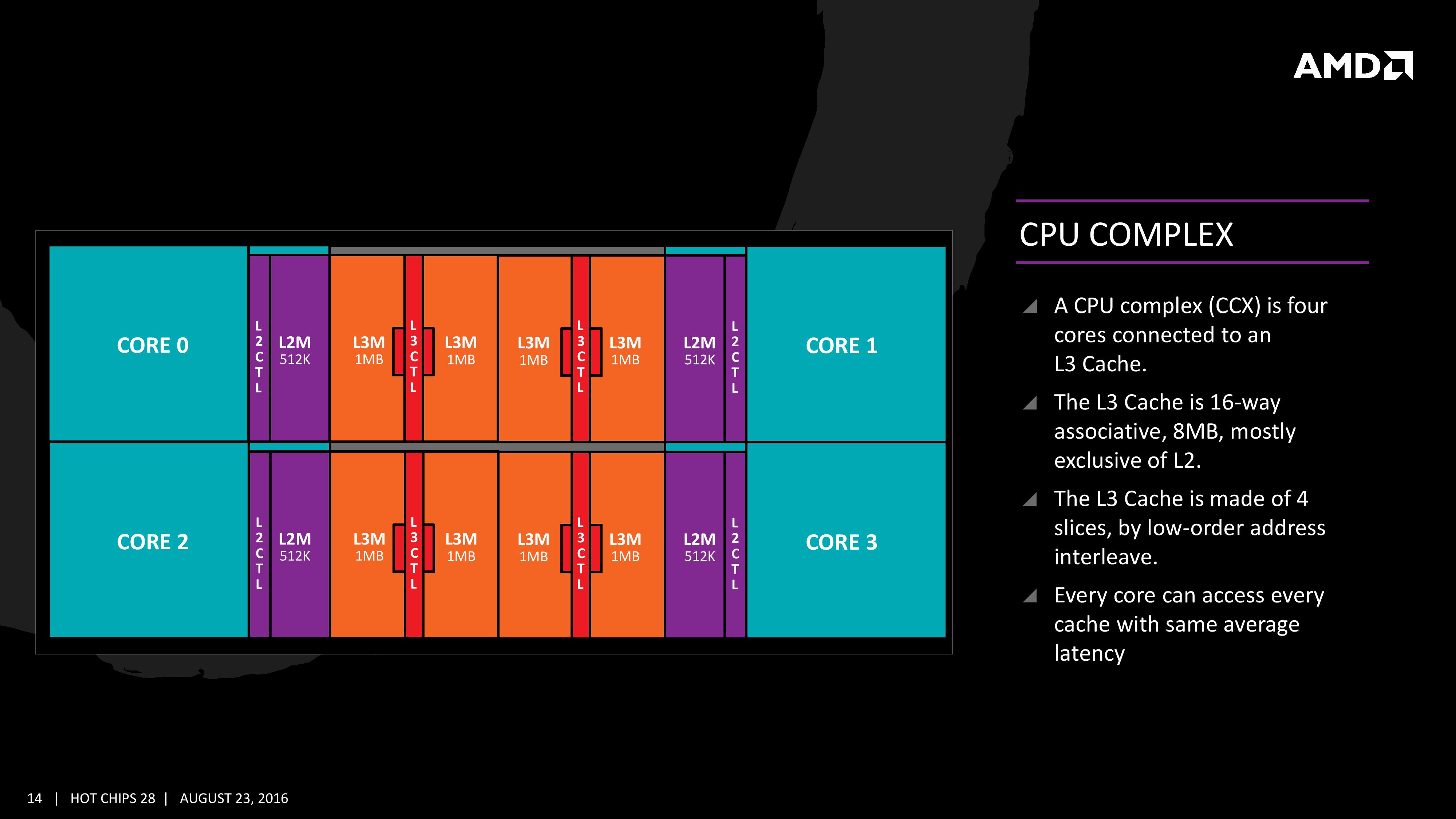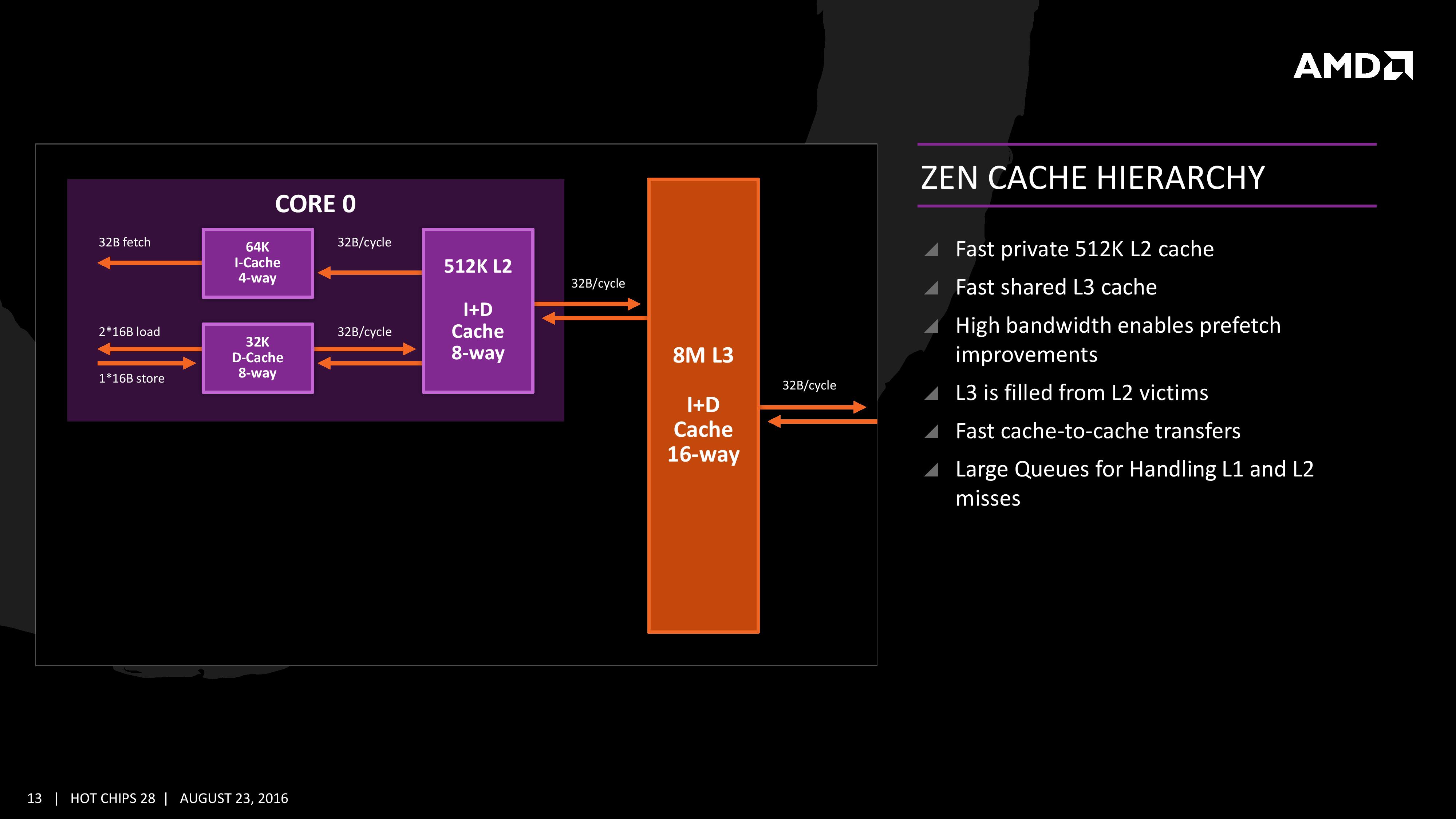The AMD Zen and Ryzen 7 Review: A Deep Dive on 1800X, 1700X and 1700
by Ian Cutress on March 2, 2017 9:00 AM ESTThe Core Complex, Caches, and Fabric
Many core designs often start with an initial low-core-count building block that is repeated across a coherent fabric to generate a large number of cores and the large die. In this case, AMD is using a CPU Complex (CCX) as that building block which consists of four cores and the associated caches.
Each core will have direct access to its private L2 cache, and the 8 MB of L3 cache is, despite being split into blocks per core, accessible by every core on the CCX with ‘an average latency’ also L3 hits nearer to the core will have a lower latency due to the low-order address interleave method of address generation.
The L3 cache is actually a victim cache, taking data from L1 and L2 evictions rather than collecting data from prefetch/demand instructions. Victim caches tend to be less effective than inclusive caches, however Zen counters this by having a sufficiency large L2 to compensate. The use of a victim cache means that it does not have to hold L2 data inside, effectively increasing its potential capacity with less data redundancy.
It is worth noting that a single CCX has 8 MB of cache, and as a result the 8-core Zen being displayed by AMD at the current events involves two CPU Complexes. This affords a total of 16 MB of L3 cache, albeit in two distinct parts. This means that the true LLC for the entire chip is actually DRAM, although AMD states that the two CCXes can communicate with each other through the custom fabric which connects both the complexes, the memory controller, the IO, the PCIe lanes etc.
The cache representation shows L1 and L2 being local to each the core, followed by 8MB of L3 split over several cores. AMD states that the L1 and L2 bandwidth is nearly double that of Excavator, with L3 now up to 5x for bandwidth, and that this bandwidth will help drive the improvements made on the prefetch side. AMD also states that there are large queues in play for L1/L2 cache misses.
One interesting story is going to be how AMD’s coherent fabric works. For those that follow mobile phone SoCs, we know fabrics and interconnects such as CCI-400 or the CCN family are optimized to take advantage of core clusters along with the rest of the chip. A number of people have speculated that the fabric used in AMD’s new design is based on HyperTransport, however AMD has confirmed that they are using a superset HyperTransport here for Zen, and that the Infinity fabric design is meant to be high bandwidth, low latency, and be in both Zen and Vega as well as future products. Almost similar to the CPU/GPU roadmaps, the Fabric has its own as well.
Ultimately the new fabric involves a series of control and data passing structures, with the data passing enabling third-party IP in custom designs, a high-performance common bus for large multi-unit (CPU/GPU) structures, and socket to socket communication. The control elements are an extension of power management, enabling parts of the fabric to duty cycle when not in use, security by way of memory management and detection, and test/initialization for activities such as data prefetch.














574 Comments
View All Comments
bobsta22 - Saturday, March 4, 2017 - link
Office with 20 PCs - all developers - loads of VMs and containers.All the PCs are due a CPU/Gfx refresh, but ITX mobos required.
Cant wait tbh. This is a game changer.
prisonerX - Saturday, March 4, 2017 - link
What if they come out with a 16 core line next year!bobsta22 - Saturday, March 4, 2017 - link
What?lilmoe - Tuesday, March 7, 2017 - link
It really is. As a freelance developer, I can't wait.ericgl21 - Saturday, March 4, 2017 - link
For me, the more important thing to see from AMD is if they can come up with a chip that can beat the mobile Core i7-7820HQ (4c/8t no ECC) & the Xeon E3-1575M v5 (4c/8t with ECC), for less money.And the number of PCIe gen3 lanes is very important, especially with the rise of M.2 NVMe storage sticks.
cmagic - Sunday, March 5, 2017 - link
Will anandtech review Ryzen in gaming? I would really like Anandtech view, since I don't really trust other sites especially those "entertainment" sites. Want to see how Anandtech dive into its main cause.Tchamber - Sunday, March 5, 2017 - link
@cmagicPage 15
2017 GPU
The bad news for our Ryzen review is that our new 2017 GPU testing stack not yet complete. We recieved our Ryzen CPU samples on February 21st, and tested in the hotel at the event for 6hr before flying back to Europe.
I just ordered my 1700X, I plan to keep it for at least 5 years, as my needs don't change much. My current Intel 6 core is coming up on 7 years old now. I like to buy high end and use it a long time.
Lazlo Panaflex - Monday, March 6, 2017 - link
Same here...probably gonna grab a 1700 at some point and put this here i5-2500 non-k in the kids computer.asH98 - Sunday, March 5, 2017 - link
'''The BIG QUESTION is WHY are the HEDT benchmarks (professional ie Blender) fairer than gaming benchmarks??Bottom line is that CUTTING-EDGE CODING is happening NOW in AI, HPC, data, and AV/AR, game coders because of $$$ are the last to change or learn unless forced (great for NVidia Intel) so most of the game coding is stuck in yesteryear- Bethesda will be the test bed for game coders to move forward
Hence the difference in game benchmarks vs 'professional' (HEDT) benchmarks. Game coders can get stuck using yesterday's code without repercussions and consequences as long as old hardware dominates and there are no incentives to change or learn new skills. The same Cant happen in the Professional area where speed is tantamount to performance and $$$
TheJian - Sunday, March 5, 2017 - link
I hope you're going to test a dozen games at 1080p where most of us run for article #2 and the GAMING article should come in a week not 1/2 year later like 1080/1070 gtx reviews...LOL. As this article just seems like AMD told you "guys, please don't run any games so we can sell some chips to suckers before they figure out games suck". And you listened. No point in testing 1440p or 4k for CPU, and 95% of us run 1920x1200 and BELOW so you should be testing your games there for a CPU test.The fact they are talking Zen2 instead of fixing Zen1 kind of makes me think most of the gaming is NOT going to be fixable.
http://www.legitreviews.com/amd-ryzen-7-1800x-1700...
149fps for 7700 in theif vs. 108 for 1800x? JEEZ. GTA5 again, 163 to 138. Deus ex MD 127 to 103. These are massive losses to Intel's chip and Deus was clearly gpu bound as many of Intel's chips hit the same 127fps including my old 4790k :( OUCH AMD.
https://www.guru3d.com/articles_pages/amd_ryzen_7_...
Tombraider same 7700k vs. 1800x 132fps to 114 (never mind 6850 scoring 140fps). This will probably get worse as we move to 1080ti, vega, nvidia refresh for xmas, Volta, 10nm etc. If you were using a faster gpu the cpus will separate even more especially if people are mostly gaming at 1080p. Even if many move to 1440p, that maybe fixes some games (tombraider is one with 1080 regular that hits a wall at 90fps), but again goes back to major losses as we move to 10nm etc. We get 10nm chips for mobile now and gpus probably next year at 12nm (real? fake 12nm? Either way) and might squeak into 2017 (volta, TSMC). 10nm gpus will likely come 2018 at the latest. Those gpus will make 1440p look like 1080p today surely and cpus will again spread out (and no, we won't all be running 4k then...LOL). You could see cpus smaller than 10nm BEFORE you upgrade your cpu again if you buy this year. That could get pretty ugly if the benchmarks around the web for gaming are not going to improve. One more point you'll likely be looking at GDDR6 (16Gbps probably) for vid cards allowing them to possibly stretch their legs even more if needed. Again, all not good for a gamer here IMHO.
“But Senior Engineer Mike Clark says he knows where the easy gains are for Zen 2, and they're already working through the list”
So maybe no fix in sight for Zen1? Just excuses like "run higher res, and code right guys"...I hope that isn't the best they've got. I could go on about games, but most should get the point. I was going to buy ryzen purely for Handbrake, but I'll need to see motherboard improvements and at least some movement on gaming VERY soon.
One more ouch statement from pcper.
https://www.pcper.com/news/Processors/AMD-responds...
"For buyers today that are gaming at 1080p, the situation is likely to remain as we have presented it going forward."
So they don't think a fix is coming based on AMD info and as noted as gpus get much faster (along with their memory speeds) expect 1440p to look like today's 1080p benchmarks at least to some extent.
The board part is of major interest to me, so I can wait a bit and also see Intel's response. So AMD has be hanging for a bit here, but not for too long. I do like the pro side of these though (handbrake especially, just not quite enough).